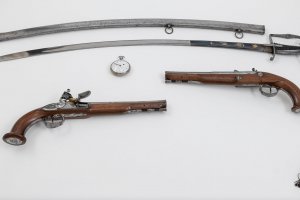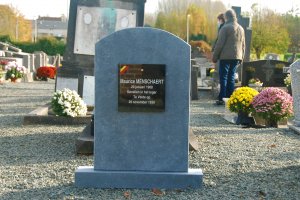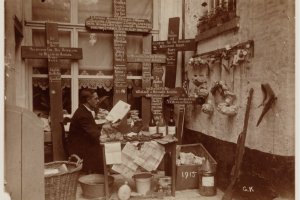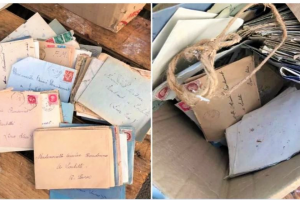News

Lieven Bauwens (1769-1822) was one of the few “Belgians” to enjoy an international reputation during the Revolution and the French Empire. He was analysing English industrial procedures when he decided, in 1798, to force the British blockade by shipping a loom, the Mule Jenny, to our country. Bauwens’ career, both swift and chaotic, was intimately linked with the economic history of the Belgian departments, and of the city of Ghent in particular. He for instance became the city’s mayor in 1800.
Napoleon visited his manufacture in 1810 and granted him the Légion d’Honneur. The weapons we acquired date from...

On Wednesday 27 January a delegation led by the Ukrainian Chief of Defence visited the Royal Military Museum. Our acting CEO, Mr Michel Jaupart, guided the visitors through our rich collections and reviewed our ambitious initiatives.
© Jérusalem Pierard (WHI)

On 27 January 1945, while still fighting the Wehrmacht, the Soviet troops discovered the concentration camp and extermination centre of Auschwitz-Birkenau. The camp was situated to the west of Cracow in Poland and is considered today as the most emblematic venue of Nazi barbarism.
Since then UNESCO chose 27 January as the date on which to pay tribute to all Shoah victims. On that day we each year reaffirm our never-ending battle against anti-Semitism, racism and all other forms of intolerance leading to targeted violence against human beings.
Click here to see a video of souvenirs in pictures of 20 ye...

Everybody can be involved in a dispute at one time or another. The parties then often agree to compromise. In November 1939 Lieutenant Maurice Menschaert and Private Porton unfortunately pushed the limits of their disagreement. Punished by the Lieutenant, Private Porton was out on revenge and he shot the lieutenant even before the outbreak of war. The latter was buried in his native town of Burst a few days later. However, his grave disappeared when the local cemetery was reorganized.
In 2019 the FNC/NSB learned about Lieutenant Menschaert’s unfortunate fate. In collaboration with local authorities the FNC/...

When the Germans attacked our country in 1914, the troops in and around Mechelen suffered heavy casualties. Soldiers barely had time to bury their fallen comrades. A hastily dug grave was the fate of many who were left behind. Time was of the essence and the City of Mechelen created an excavation service under the leadership of Hendrik Haesen during the first months of the occupation.
Hendrik and his team set out looking for these graves around Mechelen. Even calling upon the German occupier when met with uncooperative landlords. No less than 892 soldiers, of different nationalities were transferred to th...

This book presents you with a forgotten adventure, viz. that of the “national regiments” recruited in the Austrian Netherlands, i.e. present-day Belgium. They opposed both Frederic the Great and Napoleon. These volunteer elite soldiers were not that numerous, but enjoyed quite a reputation, as the Habsburg “Walloons” participated in all battles. Moreover, their officers – noblemen from a rather small territory – established an extremely professional military tradition. They played a major part in the Austrian army’s chain of command and military style.
This unprecedented approach of a largely untapped subject i...

Have you already visited a War Heritage Institute site? Or do you plan to do so, perhaps even in the near future? Participate in the War Heritage Institute survey and indicate what you expect from a visit to the War Heritage Institute.
That will enable us to match your expectations more closely.

Last Tuesday the Bovington Tank Museum “Tankmas 2020” event was presented to the public in live streaming. The War Heritage Institute had been invited to participate in the event through a short video about its collections. The stream was a success and was followed by thousands of people: almost 40,000 views up till now!
Discover the superb coverage through following links:
→ The complete video: https://www.youtube.com/watch?v=U0GxUGkgNa0
→ The War Heritage Institute fragment: https://youtu.be/U0GxUGkgNa0?t=6999
→ The Facebook Live: https://www.facebook.com/watch/?v=401343904652450

We draw your attention to an interesting item about Fernand Allard L'Olivier, the painter from Tournai, realized by Notélé. The Royal Military Museum safeguards the largest collection of works the official Belgian army painter dedicated to the First World War. A must-see!

Hundreds of love letters written during the Second World War were saved from destruction. They could be handed over to the family through a tweet by Cécile, an employee of an environmental agency in Aix-en-Provence (Bouches du Rhône) who had been detached to a recycling site in Saint-Jean-d’Angély (Charente-Maritime) for a few days. She decided to put a message on Twitter to locate the author and the addressee of the letters. Her message was shared over 10,000 times … and Cécile reached her goal: a family member contacted her through the social network. The letters belonged to Pierre and Aimée. The couple had mar...


